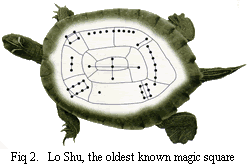

 Magic
Squares can be traced
in Chinese literature
as far
back as 2800 B.C. The
legend of "Lo
Shu" or
"scroll of the river Lo"
tells the story of a huge
flood that destroyed crops
and land. The people offered
a sacrifice to the river
god for one of the flooded
rivers, the Lo river,
to calm his anger. Everytime
the river flooded, there
emerged a turtle that
would walk around the
sacrifice. It was not
until a child noticed
a unique pattern on the
turtles shell (Figure
2) that told the people
how many sacrifices to
make for the river god
to accept their sacrifice.
There were circular dots
of numbers that were arranged
in a 3-by-3 grid pattern
such that the sum of the
numbers in each column,
row, and diagonal equaled
the same sum: fifteen.
Fifteen became the number
of sacrifices needed in
order to make the river
god happy. This number
is equal to the number
of days in each of the
24 cylces of the Chinese
solar year.
Magic
Squares can be traced
in Chinese literature
as far
back as 2800 B.C. The
legend of "Lo
Shu" or
"scroll of the river Lo"
tells the story of a huge
flood that destroyed crops
and land. The people offered
a sacrifice to the river
god for one of the flooded
rivers, the Lo river,
to calm his anger. Everytime
the river flooded, there
emerged a turtle that
would walk around the
sacrifice. It was not
until a child noticed
a unique pattern on the
turtles shell (Figure
2) that told the people
how many sacrifices to
make for the river god
to accept their sacrifice.
There were circular dots
of numbers that were arranged
in a 3-by-3 grid pattern
such that the sum of the
numbers in each column,
row, and diagonal equaled
the same sum: fifteen.
Fifteen became the number
of sacrifices needed in
order to make the river
god happy. This number
is equal to the number
of days in each of the
24 cylces of the Chinese
solar year.
 The
oldest magic square of
order four was found inscribed
in Khajuraho,
India dating
to the eleventh or twelfth
century. This magic square
is also known as the diabolic or panmagic square,
where, in addition to the
rows, columns, and diagonals
the broken diagonals also
have the same sum. The magic
square at the right shows
an example of a diabolic
or magic square.
The
oldest magic square of
order four was found inscribed
in Khajuraho,
India dating
to the eleventh or twelfth
century. This magic square
is also known as the diabolic or panmagic square,
where, in addition to the
rows, columns, and diagonals
the broken diagonals also
have the same sum. The magic
square at the right shows
an example of a diabolic
or magic square.
Magic Squares have been around for over 4,000 years and have been used in different cultures for their astrological, divinatory qualities, their usage ensuring longevity and prevention against diseases. For example, Indian and Egyptian cultures engraved magic squares onto stone or metal into gowns worn by talismans.